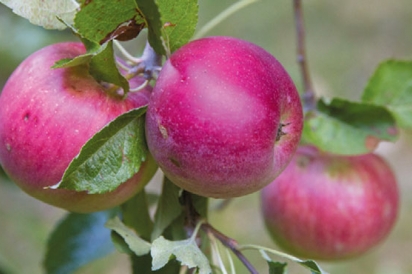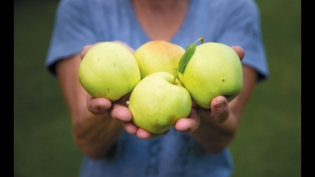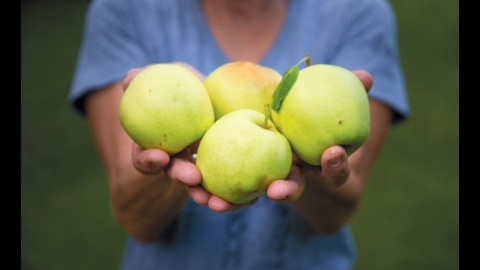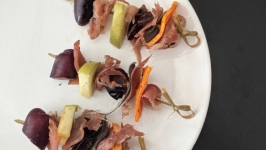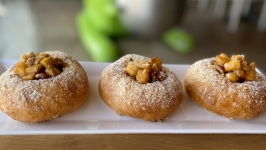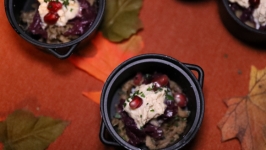Apple Ancestors
Apple Ancestors From Oak Creek Canyon
Apples have been grown in Oak Creek Canyon since the first Anglo farmers homesteaded there in the 1880s. The settlers’ peaches, pears and apples thrived in the cooler temperatures of the 4,500-foot elevation. After the turn of the century, commercial farmers arrived and built irrigation systems to water large orchards for market production. From about 1915 to 1975, tree fruits, especially apples, were the economic driver of the Sedona economy.
While most of these original orchards have gone fallow, or fallen under the developer’s axe, a few dozen acres of “remnant” orchards survive. Tucked into scattered meadows and cradled between soaring canyon walls, these orchards continue because a few long-time local families, dedicated park rangers and volunteers value the unique qualities of these apples, and the historical and cultural significance of Oak Creek fruit production.
The main apple groves are at Red Rock State Park, Junipine Resort and Garland’s Oak Creek Lodge. They are tended organically, and produce apples sold fresh or pressed for cider. According to long-time Sedona orchardist Rob Lautze, this work is no longer profitable; caring for the trees and fruit is a labor of love.
In their heyday Oak Creek apples were famous all around the State of Arizona. Today they are making a comeback. As Lautze says, “Oak Creek apples have found a niche for their organic, tree-ripened, fresh-picked qualities,” and people come from far away to savor their authenticity.
Some of the trees still producing in Oak Creek Canyon are over a hundred years old, survivors from the original orchards. To me these old apple trees with gnarly limbs and knotty trunks are silent witnesses to the lives of the pioneers who planted and pruned them, harvested the fruit, picnicked in their shade and kissed under their blossoms.
Nostalgia aside, I am also very curious about the flavors. The chance to try these heritage apples and cider is a rare, exciting opportunity to explore distinctive flavor nuances from the past, and to experiment with the heritage recipes they engendered.
In the old days, apples were prominent in the daily diet. Cider was a principal beverage consumed both fresh and aged into hard cider—one of the few alcoholic beverages available to pioneers. There were special apples or combinations of apples for every use: cider, sauce, butter, desserts, drying, baking, fresh eating and keeping. Fruit was “color picked” at ripeness, untreated and delivered fresh to local markets.
Heirloom apple varieties ripen at different times, extending the harvest season from late summer into early winter. For example, the Gravenstein (documented in Denmark, 1669 but thought to have originated in Italy or Germany) is an early-harvest fruit. It is not a good keeper, but good for juice, cooking, sauce and baking. The original Jonathan (New York, late 1700s), another early-season apple, bears young and heavily. It is an excellent eating and baking apple and also stores well. There are many descendants of this original.
Some heirloom apples were discovered by chance, found to have superior flavor and texture or keeping qualities, then selected and developed for widespread production. The Winesap (New Jersey, 1800) is one example. From this cold-tolerant, disease-resistant, top-quality multi-purpose apple was developed the Stayman Winesap (Kansas, 1866). Sometimes called the Stayman, it has the same flavor profile but bears later in the season, does well in warm climates, has larger fruit and is generally considered to be a better apple.
Grimes Golden (West Virginia, 1804) is the probable ancestor of the 20th century Golden Delicious. Crisp and sweet, it has a deep greenish yellow color, keeps well and has more complex flavor than its descendent. It serves as a good pollinator for other varieties, and was often planted at the end of rows.
Since the industrialization of agriculture some of these apples’ qualities have been sacrificed for traits more commercially suitable for the modern market, especially eye-appeal. Market apples require uniformity in shape and bright color. A coating of wax ensures a gloss and long shelf life. No matter if the apple is old and tasteless, if it looks bright and shiny it will sell. By contrast, Oak Creek apples are produced organically, picked when the color indicates ripeness, are sold un-waxed and fresh. The true character of these distinctive varieties is maintained—how rare is that?
If you wish to take an apple tour of Oak Creek Canyon and sample some of these heirlooms, the season usually starts in early to mid-August and lasts into October. Slide Rock State Park orchard is open to the public, while Junipine and Garland’s orchards are private and not open except to guests. Garland’s sells apples from their trees and some from Junipine at a number of places in the canyon (see sidebar).
Slide Rock State Park is a commercial orchard originally planted by Frank Pendly in 1910. The remains of the elaborately engineered irrigation system of ditches, pipes and flumes can still be seen on the west side of the canyon above the famous Slide Rock swimming hole.
While most of the trees at Slide Rock are a 1940s unremarkable variety of Red Delicious, there are a few notable heirlooms including an original Arkansas Black, marked with a sign dated 1910. This once-popular variety is listed on the Slow Food Ark of Taste, celebrated for its crispness, tartness and distinctive flavor. Although grown in small home orchards, it is not available in the commercial market. The Arkansas Black is a fall apple that tolerates heat, is disease resistant and keeps well through the winter, turning a deep purple over time. Its distinctive sharp flavor is said to improve as it ages,
The Black Twig (Tennessee, 1830s) is distinctive for its tart tannic qualities good for eating and especially for cider. Also growing at Junipine is the King David, Lautze’s favorite, thought to be a cross between Jonathan and Arkansas Black. The orchard also includes the Mendocino Cox, a “sport” or an exceptional offspring of the popular British variety Cox’s Orange Pippin. This apple variety was developed to adapt to the western region of the US, and has superior flavor qualities to its ancestor.
Further up the Canyon, at Garland’s Lodge there are several varieties of the original trees planted a hundred years ago. Among the most notable are the Spitzenberg, a favorite of Thomas Jefferson and also on the Slow Food Ark of Taste; and the Wolf River, so huge that the saying was “one apple makes a pie.” Also at Garland’s are an old variety of Jonathan, the Gravenstein, and the Stayman Winesap.
Way up the Canyon at West Fork is an abandoned but still beautiful orchard with very old apple trees, some of which still bear fruit. Only a few are pruned or marked, but it is lovely to stroll along Oak Creek among these patriarchs of the apple era, tasting as you go.
Around the country, the revival of heritage fruit is becoming a trend. Complex flavors, micro-climate adaptability, disease resistance and plain old historical curiosity have motivated orchardists, biologists, chefs, food aficionados, horticulturalists and home gardeners to seek out, document, grow and prepare the fruits of our ancestors.
Another feature is that these old varieties can still be produced and sold by anyone. In contrast, when a new apple variety is developed today, it comes with a new name, a patent, millions of investment dollars for promotion and exclusive rights to production. The standard Gala becomes the patented Royal Gala. Honeycrisp and Pink Lady apples are also patented. It is illegal to graft from these trees.
Whether for science, history or culinary interest, heritage trees provide a living record of the biological traits, the flavor and other qualities of the fruit. Stories abound of discovering ancient trees at old farms, the hedgerows of abandoned fields, or in the backyards of octogenarian grandmothers. The reward for this dedicated sleuthing and determined exploration? Discovering a slice of botanical history—and rare, forgotten flavors. The champions who propagate and revive these heritage fruits are preserving a treasure trove for the future, including this bounty of heirloom trees from Oak Creek Canyon!
Where to Buy:
Oak Creek apples are available for purchase during the harvest period (August through October) at the Slide Rock State Park Market, where there is also the option of U-pick, allowing one to seek out preferred varieties.
Apples-and, in season, peaches-from Oak Creek Lodge (formerly Garland’s Lodge) are available at Sedona Farmers’ Market, Flagstaff Community Market and a roadside stand on 89A in Oak Creek Canyon across from the Butterfly Gardens Inn.
For More Information:
Trees of Antiquity Nursery
treesofantiquity.com
Orange Pippen Heritage Fruit Trees
orangepippen.com
The New Book of Apples
by Joan Morgan and Alison Richards
(Ebury Press, London, 2002)




